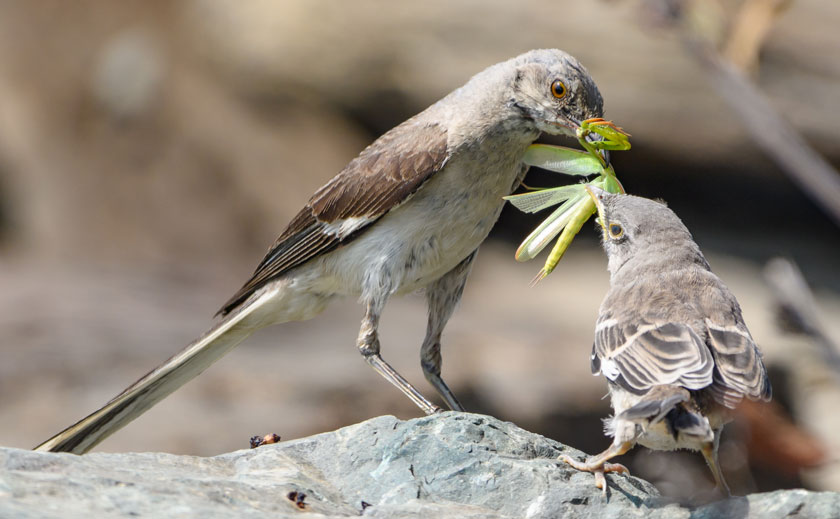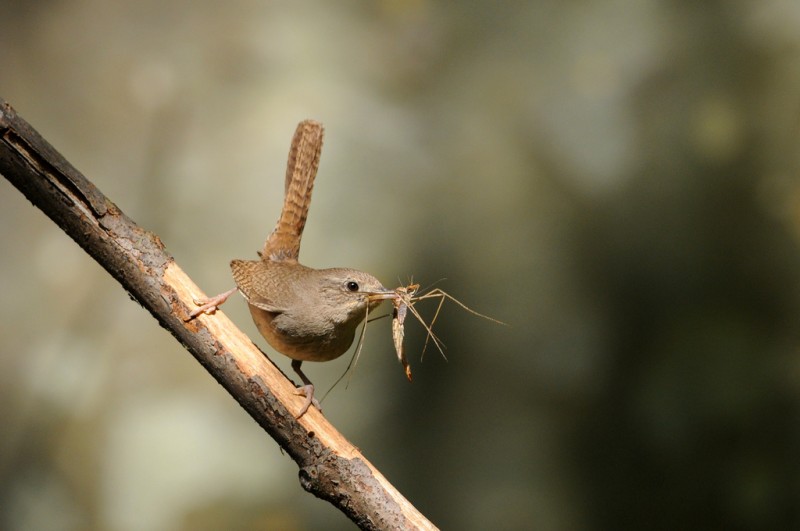This Week in the Wild is an article written and shared by Steve Burns, a wildlife conservationist. Below, Steve shares interesting evidence as to why bugs are essential to wild birds’ survival.
“There is a scene in The Lion King when Simba runs away from home and is hanging out with Timon the meerkat and Pumbaa the warthog. Timon and Pumbaa move some logs around, dig up some grubs and show the young lion how to eat them. After slurping out the insides and downing the grub, Timon describes this larva of a beetle as “slimy but satisfying.” Simba stares at the grub-loving pair with a look of shock and disgust.
I am guessing that I am a lot like you and thinking “Simba was so right.” But it turns out that a good chunk of the animal kingdom thinks “Simba was so wrong.” Insects in their various life stages are slimy but satisfying to a lot of birds, amphibians, reptiles, mammals and a lot of other insects.
To show you how important bugs are to birds you need look no farther than this list of bird names—bee eaters, flycatchers and gnatcatchers. Ants are so important to birds that there is the ant-eating chat, the striated antthrush and thrush-like antpitta not to be confused with the plain-throated antwren or the warbling antbird.

According to a 2019 article in The Guardian, birds will literally migrate halfway around the globe just to have an ample supply of insects to eat. I am not sure if what I am about to say will bug you or not, but it should—the populations of 40% of all the insect species in the world are in decline. One-third are now endangered.
In case you don’t subscribe to the periodical Ornithological Applications, let me tell you about one of its recent articles written by two University of Delaware professors Doug Tallamy and Greg Shriver. In their article they point out that in the last 50 years, the U.S. and Canada have lost 39% of all their birds. These birds didn’t necessarily go extinct, there are simply 39% fewer birds than there were in 1970. This decline did not happen evenly across all species. The populations of birds that don’t eat insects declined by 26 million. The populations of birds that do declined by 2.9 billion! That stings.

The same Guardian article points out that each year we are losing 2.5% of the total mass of insects. For now, the total weight of all the insects is 17 times greater than the weight of all the people on earth. While a lot of animals eat insects, a lot of insects eat plants for at least part of their life. Unfortunately, we’ve put insects on a diet. This may seem strange to you. As you look out your window, I am sure you can see hundreds if not thousands of plants. Turns out that most insects are picky eaters, specializing on just one or two plant species. A lot of insects are like your 6-year-old when you drop a healthy portion of lima beans onto their plate. Those beans are going to sit there long enough to sprout roots, grow a stalk and support a giant named Jack.

The dilemma is that we’ve planted a lot of plants that are not native to the U.S. Most of the plants that we plant in our yards and parks are not from this country and a lot of insects have not developed a taste for them. According to Professor Tallamy in his book, Nature’s Best Hope, we have introduced 3,300 species of plants into the U.S. And just like those lima beans for the six-year-old, most of them are inedible to bugs. It takes a long time to acquire new tastes. Phragmites, a plant introduced into U.S. wetlands 500 years ago, only supports 3% of the insects that it does in Europe where it is native. Many of us have planted the wonderfully named Butterfly Bush in our backyards. However, the butterfly bush, another introduced species, only supports the caterpillar stage of 1 of our country’s 725 native butterfly species.
Caterpillars, like grubs, are slimy but satisfying to many of the animals that eat them. Caterpillars are particularly important to bird chicks. As Dr. Tallamy found out, the Carolina chickadee will feed tens of thousands of caterpillars to one year’s clutch of its chicks. Imagine that. One set of parents feed their kids tens of thousands of caterpillars during a 6 week or so period of time. Now imagine if there are thousands of birds in an area all trying to do the same. If there aren’t the right plants to eat then there are no caterpillars. No caterpillars, no baby birds. You can begin to understand the drop of 2.9 billion when you do all the math. By now, I hope what I am writing is really starting to bug you.

I recently read Nature’s Best Hope. In his book, Dr. Tallamy introduces a concept called the “Homegrown National Park.” His idea is for Americans to plant the right plants and create better habitats in their backyards to support bugs and birds and bats and all the other beings that belong there. All our backyards add up to 20 million acres, which is 10 times bigger than Yellowstone National Park. It is not a perfect solution, but it is practical and possible.
Two things you can do this week is to pick up a copy of Nature’s Best Hope and give it a read. I learned so much. The second thing you can do is to check out your native plant society to see which plants should actually be growing in your backyard and hopefully plant one or two now that Spring is upon us.
Less bugs may seem like a good thing to you, especially if they are mosquitos. But the world as we know it can’t survive without them. The lack of bugs would soon bug you more than the bugs themselves. ”
– This Week in the Wild by Steve Burns

We want to give a huge thanks to Steven Burns for allowing us to re-share his story. We found his thoughts and research to be extra special and beneficial to you and birds!
Let’s start getting to work to help our feathered friends. Spring is here and Chirp Nature Center wants to help get you prepared. Now is the time to start thinking about landscaping your yard with native plants. Plants in this region of San Bernardino County, as an example, have become drought tolerant over the years. Planting native plants in your yard is not only good for the environment, but also require less maintenance than those trying to acclimate to new surroundings, which means they will save you time, water, and money. Not to mention, your yard will look beautiful with flowers, shrubs, and trees.
Additional resources include:
How To Turn Your Garden Or Yard Into A Certified Wildlife Habitat
Spring Has Sprung! How To Make Your Yard Bird-Friendly This Season
Love these types of stories? Get educational articles and more directly to your inbox by signing up for our newsletters. Thank you for supporting Chirp. Read more for actionable ways to support your local businesses (and enjoy services and products you may not have been exposed to before). View article.


